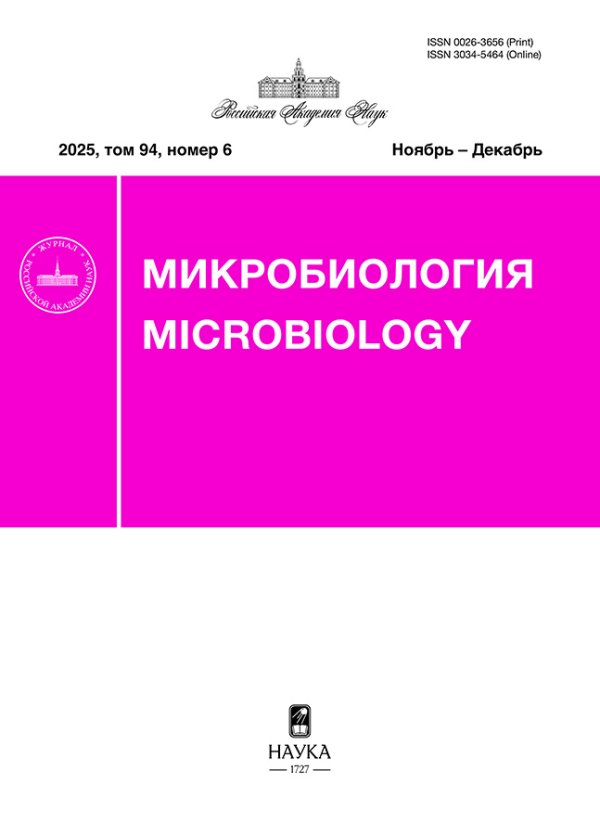Vol 92, No 4 (2023)
EXPERIMENTAL ARTICLES
Paludisphaera mucosa sp. nov., a Novel Planctomycete of the Family Isosphaeraceae from a Boreal Fen
Abstract
Abstract—Planctomycetes are common inhabitants of northern wetland ecosystems. In this study, a new planctomycete of the genus Paludisphaera, strain Pla2T, was isolated from a boreal fen in Russia. The novel isolate was represented by nonmotile, pink-pigmented, spherical cells that multiplied by budding and occurred singly or were assembled in small aggregates. Strain Pla2T was a chemoorganotrophic, psychrotolerant mesophile with a growth optimum at pH 5.5‒6 and 15‒20°C. The preferred growth substrates were polysaccharides, including xylan, xanthan gum, and phytagel, as well as some sugars. The 16S rRNA gene sequence of strain Pla2T displayed the highest similarity (97.9%) to that of ‘Paludisphaera soli’ JC670T isolated from highland soil of the western Himalayas. With other members of the genus Paludisphaera, “P. rhizosphaerae” JC665T and P. borealis PX4T, this similarity was 97.0 and 93.8%, respectively. The genome of strain Pla2T was 8.21 Mb in size and contained about 6500 protein-coding genes and 3 copies of the rRNA operon. The DNA G + C content was 67 mol %. The average nucleotide identity between the genome sequence of strain Pla2T and those of previously described members of the genus Paludisphaera was between 79.4 and 82.6%. This genotypic distance as well as several phenotypic differences allowed classifying the new planctomycete from a fen as representing a novel species of the genus Paludisphaera, Paludisphaera mucosa sp. nov. with the type strain Pla2T (=KCTC92668T = VKM B-3698T).
 347-357
347-357


Desulfobotulus pelophilus sp. nov., an Alkaliphilic Sulfate-Reducing Bacterium from a Terrestrial Mud Volcano
Abstract
Abstract—An alkaliphilic, sulfate-reducing, anaerobic bacterium (strain H1T) was isolated from a terrestrial mud volcano at the Taman Peninsula, Russia. The cells of the isolate were gram-negative motile vibrios, 1 µm in diameter and 2.0–2.5 μm in length. Strain H1T grew at 14–42°C (optimum at 37°C), pH 8.5–10.5 (optimum at pH 9.5), and NaCl concentrations of 0.5–6% (wt/vol) (optimum at 0.5–1.5%); pyruvate, lactate, butyrate, caproate, or pelargonate were used as electron donors, and elemental sulfur, sulfite, or sulfate were used as electron acceptors. Pyruvate and lactate were fermented. No growth occurred in the presence of oxygen. Thiosulfate, DMSO, fumarate, nitrate, nitrite, arsenate, selenite, and Fe(III) were not used as electron acceptors. Elemental sulfur, thiosulfate, and sulfite were not disproportionated. Glucose, fructose, sucrose, trehalose, galactose, xylose, fumarate, citrate, yeast extract, and peptone were not fermented. Predominant fatty acids were C20:0 (54.2%), C22:0 (24.6%), and C18:0 (11.1%). The genome of strain H1T was 3.66 Mb in size and had G + C DNA content of 51.1%. The genome contained the genes encoding the enzymes of dissimilatory sulfate reduction and β-oxidation of fatty acids. According to the results of analysis of the 16S rRNA gene sequence, Desulfobotulus mexicanus was the organism most closely related to strain Н1Т (98.3% similarity). Based on its phenotypic characteristics and the data of phylogenetic analysis, affiliation of the isolate as member of a novel Desulfobotulus species, Desulfobotulus pelophilus sp. nov., is proposed, with the type strain H1T (=DSM 112796T = VKM B-3697Т =UQM 41590T).
 358-365
358-365


Role of the Structural and Functional Genes Encoding Heat Shock Proteins in Biosurfactant Synthesis by Rhodococcus pyridinivorans 5Ap
Abstract
Abstract—The role of groESL and dnaJ structural genes and hrcA regulatory gene, encoding the synthesis of heat shock proteins, in biosurfactant synthesis by R. pyridinivorans 5Ар was determined. The CIRCE binding sites for the regulatory protein coded by hrcA gene were revealed in the promoter regions of groESL, groEL2, and fmdB genes. GroESL and groEL2 genes expression during the late exponential phase in the medium with hexadecane at 42°C was higher than at 28°C (4.4 and 5.3 times, respectively). At the same time, no changes in expression of hrcA and fmdB genes were observed at two different temperature modes (28 and 42°C). In the absence of the negative regulator HrcA, groESL expression increased 14.4 and 3.5 times, that of groEL2, 9.6 and 2.7 times, and that of fmdB, 1.82 and 2.52 times at 28 and 42°C, respectively. Products of dnaJ and hrcA genes were required for trehalolipid synthesis at different temperature modes, with their role increasing at higher temperature (synthesis of trehalolipids by the mutant with impaired dnaJ gene decreased 1.8 and 2.5 times compared to 1.5 and 6.6 times, for the mutant with impaired hrcA at 28 and 42°C, respectively). At the same time, emulsifying activity of all mutant variants did not change at 28°C and decreased 1.4 and 1.9 times 42°C for the mutants with impaired groESL and hrcA genes, respectively. Our results indicated the complex chemical nature of the biosurfactants produce by R. pyridinivorans 5Ар (emulsifiers, including trehalolipids and compounds of other chemical composition). The Gro chaperones and the HrcA regulatory protein play the key roles in synthesis of these compounds at different temperature modes, while the dnaJ is required only for trehalolipid synthesis.
 366-375
366-375


Effect of Hormones and Biogenic Amines on Growth and Survival of Enterococcus durans
Abstract
Abstract—Lactic acid bacteria (LAB) are important components of the human microbiome. While they are capable both of synthesis and response to the signals of the human humoral regulatory system (hormones and neuromediators), the phenomenology and mechanisms of the LAB response to these mediators are insufficiently studied. This work showed estrogen to hinder the growth and development of E. durans, while norepinephrine, estrogen, and the brain natriuretic peptide caused dose-dependent extension of the stationary growth phase. This is the first report on stimulation of E. durans biofilm formation by the atrial natriuretic peptide and estrogen. The frequency of persister formation depended on the type of bacterial growth (planktonic or biofilm one) and was higher in the case of biofilm growth. Epinephrine and norepinephrine exhibited dose-dependent stimulation of persister formation in planktonic LAB cultures, while other tested hormones inhibited it. The effect on persister formation in biofilms was different: natriuretic peptides exhibited dose-dependent stimulation of persister formation, and none of the hormones inhibited it significantly. After several months of incubation, E. durans persister cells matured to anaaaaaaaaabiotic dormnt forms with the typical ultrastructural features. The population of E. durans dormant forms was first shown to contain the form with different dormancy depth, including the viable uncultured ones.
 376-395
376-395


Physiological Characteristics of Saccharomyces cerevisiae Strain Overexpressing Polyphosphatase Ppx1
Abstract
Abstract—The Ррх1 exopolyphosphatase of yeast is a constitutive protein localized predominantly in the cytoplasm. The purified enzyme hydrolyzes inorganic polyphosphates with high activity; however, in the knockout ∆ppx1 mutant of Saccharomyces cerevisiae the increase in the polyphosphate level was small, and no changes in physiological properties of this mutant were observed. To elucidate the functions of Ppx1, we studied the physiological characteristics of the S. cerevisiae strain overexpressing this enzyme. When cultivated in the YPD medium, the strain overexpressing Ppx1 showed no growth features different from those of the parental strain. The following physiological features of the strain overexpressing Ppx1 were observed at the stationary stage of growth: the level of ATP increased by nine times, the activity of vacuolar ATPase significantly decreased, and the sensitivity to peroxide increased compared to the parental strain. The level of reactive oxygen species doubled, while the degree of lipid oxidation remained the same as in parental strain. Since overexpression of Ppx1 under the culture conditions used did not affect the polyphosphate level, these polymers were not the regulators of the changes described above. Response to oxidative stress and vacuolar ATPase activity in yeasts is known to be regulated by cAMP, while Ppx1 is capable of hydrolyzing this signaling compound. We suggest that one of the functions of Ppx1 in yeasts is participation in the regulation of cAMP level.
 396-403
396-403


Biodiversity and Metabolic Properties of Bacterial Communities from the Digestive System of the Bivalve Crenomytilus grayanus
Abstract
Abstract—Biodiversity of the bacterial communities in the digestive system of Crenomytilus grayanus inhabiting the coastal Sea of Japan waters with chronic anhropogenic pollution was investigated using metabarcoding. Apart from marine bacteria, the taxa typical under contamination with oil (Rhodobacteraceae, Corynebacteriaceae), heavy metals (Asinibacterium), and unprocessed municipal waste (Cloacibacterium, Globicatella) were revealed in the microbiota. A collection of 411 cultured heterotrophic bacterial strains isolated in the course of this study was characterized taxonomically. The intestinal microbiome of the studied mollusks was shown to have a unique composition, depending on their habitat. Ability of bacterial strains isolated from the C. grayanus digestive system to degrade various nutrient substrates (sugars, amino acids, and polysaccharides) and xenobiotics (oil hydrocarbons, bisphenol A, and atrazine) was studied. Most isolates degraded a broad range oforganic substrates; 13% (54 strains) oxidized oil hydrocarbons; 1% (4 strains) oxidized bisphenol A; and 0.5% (2 strains) degraded atrazine. The possible role of the microbiome C. grayanus microbiome in symbiotic digestion and in detoxication of the mollusk is discussed.
 404-417
404-417


Analysis of the Key Determinants of Naphthalene Degradation by Rhodococcus pyridinivorans 5Ар
Abstract
Abstract—Wild-type cells of Rhodococcus pyridinivorans 5Ар were found to be highly efficient naphthalene degraders, completely utilizing this compound (500 mg/L) after 3 days, and may be used for remediation of naphthalene-contaminated aquatic ecosystems. Inactivation of the biodegradation genes narAa (encoding the large subunit of naphthalene dioxygenase) and narB (encoding cis-naphthalene dihydrodiol dehydrogenase) resulted it the loss of ability to use naphthalene as the sole energy source, which indicated the absence in the genome of R. pyridinivorans 5Ар of the determinants responsible for alternative pathways of naphthalene oxidation. Moreover, narB inactivation resulted in accumulation of a polar colored compound (probably a product of primary naphthalene oxidation) in the medium.
 418-426
418-426












